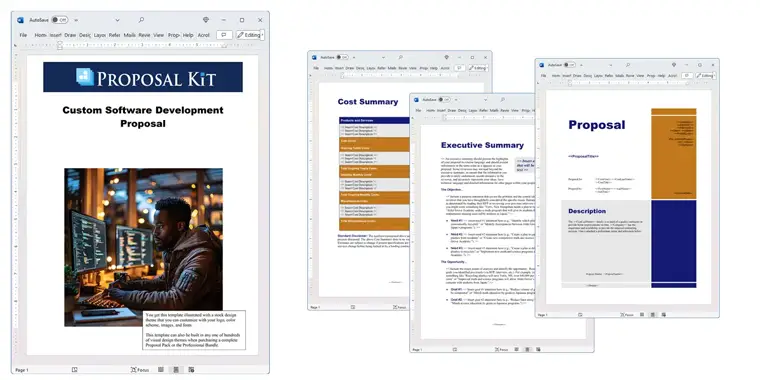How to write your Custom Software Development Proposal
We include this 22 page layout with every Proposal Pack. If you want this template to have a different visual design theme than the one illustrated here, purchase any Proposal Pack design and create this template using the purchased design theme. This template is included in every Proposal Pack. If you get a Proposal Pack or the Professional Bundle, you can also make any variation of this template with different chapters to suit your needs.
We typically include more chapters in the templates than most people will need to give everyone more variety in the chapters they may need. You can trim down a long template by removing pages you do not need or combining multiple chapter topics into one page.
 DOWNLOADABLE, ONE-TIME COST, NO SUBSCRIPTION FEES
DOWNLOADABLE, ONE-TIME COST, NO SUBSCRIPTION FEES If you need this template on DVD media order from our Amazon shop.
If you need this template on DVD media order from our Amazon shop.
You can also create countless variations of this document to suit your needs using the included library of 2200+ chapters if ordering a Proposal Pack or Pro Bundle.
 What Our Clients Say
What Our Clients SayI received a response stating all parties were extremely impressed. I will revise to include additional details and the non-disclosure form. I received a second request for a proposal and completed it earlier this week using Proposal Kit and Proposal Wizard."
Related Article
Related Video
Related Templates
- Software Installation and Training Proposal
- Technology Consulting Proposal
- Artificial Intelligence Project Funding Proposal
- IT Product and Service Sales Proposal
- Software System Testing Project Proposal
- Software Automation Proposal
- Training Services for Software Proposal
- Software and Hardware System Proposal
- Software as a Service (SAAS) Proposal
- Defense Contracting Intelligence System Proposal
- Mobile App Software Development Proposal
- Sales and Inventory System Development Proposal
- Web Site Creation and Software Integration Project
- Home Assistant Artificial Intelligence Project Proposal
- FinTech System Integration Proposal Template
- Prescription Monitoring Software Proposal
- Managed Services IT Proposal
- Artificial Intelligence Proposal Template
- Chatbot Services Proposal Template
- App Development Proposal Template
- Chatbot Development Proposal Template
- AI Based Content Creation Proposal Template
- Mental Health Communication and Tracking App Proposal
- AI Based Fitness Coaching Platforms Proposal Template
- AI Proposal Template
- IT Operations Finance Banking Proposal Template
- EMV Chip and Pin Migration Proposal
- Software Beta Testing Project Proposal
- Software Licensing Sales Proposal
- AI Powered Educational Tools Proposal Template
- AI Personal Assistants for Productivity Proposal Template
What's the Best Way to Write Your Custom Software Development Proposal?
Writing a custom software development proposal presents a unique challenge, especially for those unfamiliar with the nuances of proposal writing. The most efficient solution is using a Proposal Kit template or software package. Proposal Kit streamlines the proposal creation process, incorporating everything from line item quoting databases for detailed financial documents to structured templates guiding you through each proposal section. This system ensures a comprehensive approach to proposal writing, covering cost summaries, quotes, estimates, budgets, and more.
Proposal Kit Professional caters to software developers with software development contracts in addition to its software proposal content.
If you're drafting a proposal for a custom software development project, you might be wondering where to start. Proposal Kit provides a structured approach to proposal writing, offering a range of templates and tools designed to make the process more manageable and effective.
What Types of Projects Are Custom Software Development Proposals Written For?
Custom software development can vary widely depending on the needs of the client. Common types of projects include:
- CRM (Customer Relationship Management) system development
- E-commerce platform development
- Mobile app development for Android and iOS
- Custom ERP (Enterprise Resource Planning) systems
- Web application development
- Cloud computing solutions
- Blockchain technology applications
- AI (Artificial Intelligence) and machine learning solutions
- IoT (Internet of Things) device integration
- Database management systems
Chapters this template is built with
Proposal Kit's templates can be crucial in developing your proposal, covering every necessary aspect to ensure a well-rounded submission. Here's how you can use these templates.
These topics, just a fraction of what's available in the Proposal Kit library, allow you to tailor your proposal precisely to your project needs. Each document within the Proposal Kit functions as a template in a Word format document, which you can customize and save as a PDF for delivery.
Cover Letter
The cover letter serves as the initial handshake with your prospective client. In it, you'll introduce your company, emphasizing its expertise and passion for software development. Highlight your excitement about the project and your company's readiness to tackle its challenges. The tone should be professional yet enthusiastic, underscoring your eagerness to deliver solutions that exceed the client's expectations.
Non-Disclosure Form
Including a Non-Disclosure Form at the outset of your proposal demonstrates a commitment to confidentiality and integrity. It reassures the client that any proprietary information shared during the proposal process will be safeguarded, fostering a foundation of trust and professionalism from the very beginning.
Estimate
A comprehensive estimate section is crucial, outlining the anticipated costs for development, testing, deployment, and any additional features or services requested. This estimate should be itemized to provide clarity and transparency, helping the client understand the value and rationale behind each cost component.
Features
Detail the unique features and functionalities of the proposed software solution, tailored specifically to the client's needs. Highlight how these features address the client's problems or opportunities and their benefits over existing solutions. This section should illustrate your understanding of the client's requirements and ability to deliver a custom-fit solution.
Life Cycle
Describe the software development life cycle you intend to follow, from the initial planning and design phases through implementation, testing, and ongoing maintenance. This will provide the client with a clear roadmap of the development process and set expectations for each project phase.
Methodology
Clarify your team's development methodology, whether Agile, Waterfall or a hybrid approach. Explain why the chosen method is best suited for this project and detail how it will facilitate efficient development and ensure its success within the given timelines.
Project Background
Give context to the project by discussing the specific problem it aims to solve or the opportunity it seeks to capitalize on. This section should connect the project's goals with the broader objectives of the client's organization, demonstrating your understanding of their business needs.
Project Management
Detail the project management strategies you will use to ensure the project remains on schedule and within budget. Include information on timelines, milestones, reporting mechanisms, and communication protocols to offer the client a glimpse into your project management prowess.
Installation Schedule
Offer a clear installation schedule for the software, including any necessary rollout phases and training for the client's staff. This section should address logistics and provide a timeline for the software's full operationality.
Hardware and Software
List the hardware and software prerequisites for the developed solution to run effectively. This ensures the client is aware of any additional investments or upgrades needed to support the new software, avoiding future surprises.
Assumptions
State any assumptions made during the proposal preparation. These might include assumptions about the client's infrastructure, timelines, or specific requirements. Clarifying these assumptions helps align expectations and mitigates the risk of misunderstandings.
Customer Support
Outline the customer support and maintenance services you will provide post-development. Detail the scope of support, availability hours, and any included updates or maintenance intervals, emphasizing your commitment to long-term partnership and solution sustainability.
Evaluation
Describe how the software's success will be evaluated against the project's initial goals and objectives. This could involve specific performance metrics, user satisfaction surveys, or other criteria agreed upon with the client.
Acceptance Criteria
Define the project's acceptance criteria, ensuring they align with the client's expectations. These may include performance benchmarks, feature completion, and compliance with specified requirements, providing a clear basis for project completion and acceptance.
Company History
Share a brief history of your company, focusing on your experience and achievements in software development. Highlight any awards, recognitions, or significant milestones demonstrating your expertise and field success.
References
Provide references from past clients, offering insights into successful projects and satisfied customers. These testimonials can build confidence in your capabilities and reinforce your reputation as a reliable software development partner.
Our Clients
Highlight some of your most notable clients and projects, especially those relevant to the prospective project. This will showcase your experience and versatility and illustrate your ability to handle diverse software development challenges.
Team Members
Introduce the key team members involved in the project, detailing their roles, skills, and experience. This personalizes the proposal, allowing the client to see the expertise and commitment of the individuals behind the project.
Quality Control
Detail the quality control measures and standards your team adheres to, ensuring the software meets or exceeds industry benchmarks. This section should reassure the client of your dedication to delivering high-quality, reliable software solutions.
Use cases for this template
Alex's Tech Breakthrough
Alex's journey began with his small tech startup's ambition to make a significant mark in the software development industry. With a team of innovators but limited recognition, Alex convinced a substantial client that his company was the right choice for a highly competitive project. The project involved developing a cutting-edge application designed to revolutionize the client's operations, demanding technical excellence and a deep understanding of the client's unique challenges and goals.
Alex meticulously outlined his approach using the Proposal Kit, emphasizing his startup's commitment to leveraging the latest technologies and methodologies to deliver a tailor-made solution. The proposal included a detailed breakdown of the project's phases, from initial concept and design through development, testing, and deployment, accompanied by clear timelines and deliverables for each stage. The Proposal Kit's templates enabled Alex to present a competitive and transparent financial estimate detailing the costs involved and the value they represented.
What set Alex's proposal apart was how it mirrored the client's vision, showing a deep engagement with their objectives and a clear path to achieving them. The proposal detailed the innovative features of the software solution, its scalability, and how it addressed the specific pain points faced by the client. When the client reviewed Alex's proposal, they saw a vendor and a partner genuinely invested in their success. Winning the project was a watershed moment for Alex's startup, earning it a place on the industry map and opening doors to new opportunities and challenges.
Jordan's Swift Solution
Jordan's challenge was not uncommon in the business of software development: a demanding project with a tight deadline and high expectations. The project involved creating a complex software system that integrated multiple legacy systems for a key client. It required a nuanced understanding of the existing infrastructure and a clear plan for seamless integration without disrupting ongoing operations.
Turning to the Proposal Kit for structure and guidance, Jordan could quickly organize her thoughts and outline the proposal. To fill in the technical sections with the necessary depth and precision, Jordan utilized an AI writing tool, inputting critical details about the project's requirements and her company's proposed solutions. This hybrid approach allowed her to efficiently produce a draft that covered all the bases, from the software's architecture and security features to the timeline and budget.
The Proposal Kit templates helped Jordan structure the proposal in a logical and compelling way, ensuring that each section flowed into the next and built a strong case for her firm's capabilities. Meanwhile, the AI-generated content was refined and personalized, adding a layer of detail and insight that might have taken days to compile. The result was a comprehensive proposal that met the client's detailed requirements and highlighted the proposed solution's strategic benefits, ultimately securing the project. Jordan's success demonstrated the power of leveraging the right tools to enhance efficiency and effectiveness in proposal writing.
Taylor's Global Initiative
Taylor's mission was driven by a vision to make a tangible difference in the world through her non-profit's work. The challenge was to develop a custom software solution capable of tracking and managing data for projects spread across remote and often inaccessible areas. This software needed to be robust, user-friendly, and capable of operating in low-connectivity environments, presenting a unique set of requirements for potential development partners.
With Proposal Kit, Taylor could articulate her project's complex needs and aspirations into a clear and comprehensive Request for Proposals (RFP). The RFP outlined not just the technical specifications but also the project's impact goals, emphasizing the need for a technologically advanced solution that aligned with the non-profit's mission of making a lasting difference in the communities it served.
The clarity and thoroughness of the RFP, facilitated by Proposal Kit's structured approach, attracted interest from leading software development companies around the world. Each proposal submitted in response was a potential solution to a pressing need. Still, Taylor's methodical use of the Proposal Kit allowed her to effectively evaluate them against the project's specific criteria. Ultimately, she selected a partner whose vision, technology, and approach resonated with the non-profit's goals, setting the stage for a successful collaboration that would enhance the organization's ability to achieve its mission on a global scale.
Conclusions and Recommendations
Proposal Kit provides the tools and templates to write a winning custom software development proposal. Its comprehensive approach simplifies the proposal writing process, enabling you to focus on what truly matters-solving your client's problems with innovative software solutions. From drafting a compelling cover letter to outlining detailed project management plans, Proposal Kit is your go-to resource, ensuring your proposal stands out and successfully secures your next software development project.
Also Known As
This template may also be referred to in different ways or be used in more specialized situations, such as:
- Tailored Software Development Plan
- Bespoke Software Solution Proposal
- Customized Software Project Submission
- Personalized Software Design Proposal
- Tailor-Made Software Development Offering
- Unique Software Proposal
- Specialized Software Development Document
- Custom Software Planning Proposal
- Dedicated Software Development Request
- Individualized Software Solution Framework
Abstract
 Creating a custom software development proposal can seem daunting, but with the right tools, it becomes a manageable task. A well-structured proposal serves as an important communication tool between a software company and its potential clients. Using a software proposal template, such as that offered by Proposal Kit, can streamline the entire process. This detailed proposal guide ensures you cover all important details, from a project overview to specific features, and helps present a proposal that speaks directly to decision-makers.
Creating a custom software development proposal can seem daunting, but with the right tools, it becomes a manageable task. A well-structured proposal serves as an important communication tool between a software company and its potential clients. Using a software proposal template, such as that offered by Proposal Kit, can streamline the entire process. This detailed proposal guide ensures you cover all important details, from a project overview to specific features, and helps present a proposal that speaks directly to decision-makers.
A custom software development proposal typically begins with an introduction, offering potential clients a high-level overview of the project. This section serves to inform them about the potential reasons for the proposal and its relevance to their business needs. By identifying the specific needs of the potential client, the proposal outlines a tailored software product, addressing market risks and budgetary concerns. The document emphasizes the company's track record of past projects, including success stories that provide social proof and establish credibility.
A robust proposal will include sections on key deliverables, expected time periods, and different pricing options. It ensures the client's concerns about market changes, such as changing legislation or outside forces, are addressed. By offering clear timelines, payment structures, and quality control measures, the proposal aids in decision-making for stakeholders.
 The methodology and training procedures are also crucial components, explaining how the development process will unfold and what training will be provided to ensure a smooth transition. This includes specific features of the software, coding practices, and customization options that align with the client's goals.
The methodology and training procedures are also crucial components, explaining how the development process will unfold and what training will be provided to ensure a smooth transition. This includes specific features of the software, coding practices, and customization options that align with the client's goals.
Finally, outlining the next steps in the proposal-such as the sender's contact information, signatures, and acceptance criteria-ensures the proposal is complete and ready for the client's sign-off. This comprehensive approach guarantees that potential clients have enough detail to make informed decisions, ensuring the final result meets their specific needs and expectations.
Using a detailed proposal format and related templates can significantly enhance the effectiveness of a custom software development proposal. By incorporating important information and addressing potential client concerns, a well-written proposal not only highlights a company's expertise but also sets the stage for successful project implementation and long-term partnership.
 At the heart of any successful proposal is a well-articulated project overview. This section offers an accurate depiction of the project scope, laying the groundwork for the entire proposal. By detailing the client's specific needs, the proposal can identify the important details that will guide decision-making. Including past projects and success stories provides potential clients with social proof, reinforcing the software company's credibility and reliability.
At the heart of any successful proposal is a well-articulated project overview. This section offers an accurate depiction of the project scope, laying the groundwork for the entire proposal. By detailing the client's specific needs, the proposal can identify the important details that will guide decision-making. Including past projects and success stories provides potential clients with social proof, reinforcing the software company's credibility and reliability.
Incorporating sections on market and budgetary risks is also vital. By addressing these concerns head-on, the proposal demonstrates foresight and preparedness, which can reassure decision-makers. Highlighting potential outside forces, such as changing legislation, allows the proposal to showcase its adaptability and forward-thinking approach, ensuring the project remains on track despite potential challenges.
The proposal should also offer potential clients a range of pricing options, including hourly rates and subscription models. This flexibility can be a deciding factor for clients who need to align their software investment with budgetary constraints. Detailed cost estimates and clear communication regarding payment schedules help prevent misunderstandings and build trust. This transparency speaks directly to the potential client's need for clarity and assurance in their financial commitments.
 A section dedicated to the company's branding and unique value proposition can further differentiate the proposal. By showcasing the software company's innovative approach and customization capabilities, the proposal highlights how it can deliver a tailor-made solution that aligns with the client's goals. Including examples of previous work and testimonials from satisfied clients can further bolster the proposal's appeal and persuasive power.
A section dedicated to the company's branding and unique value proposition can further differentiate the proposal. By showcasing the software company's innovative approach and customization capabilities, the proposal highlights how it can deliver a tailor-made solution that aligns with the client's goals. Including examples of previous work and testimonials from satisfied clients can further bolster the proposal's appeal and persuasive power.
Furthermore, the proposal should outline a smooth transition plan that includes a comprehensive training procedure. By detailing how the client's team will be equipped to use the new software, the proposal demonstrates a commitment to long-term success and partnership. This section can also address any concerns about the implementation process, ensuring stakeholders are confident in the project's eventual success.
Finally, the proposal should culminate with a clear call to action, such as an accept button or a section for signatures, ensuring the client can quickly move forward with the agreement. By providing a precise roadmap of the next steps, including contact information and timelines, the proposal facilitates a seamless progression from consideration to commitment.
 In conclusion, a well-written custom software development proposal is more than just a document; it is a tool that can significantly influence the potential client's decision-making process. By incorporating a detailed proposal format and addressing all important aspects-from project initiation to the final result-the proposal not only captures the client's interest but also lays the foundation for a successful and rewarding collaboration.
In conclusion, a well-written custom software development proposal is more than just a document; it is a tool that can significantly influence the potential client's decision-making process. By incorporating a detailed proposal format and addressing all important aspects-from project initiation to the final result-the proposal not only captures the client's interest but also lays the foundation for a successful and rewarding collaboration.
Frequently Asked Questions
What should be included in a custom software development proposal?
A custom software development proposal should include several key elements to be comprehensive and practical. Start with an executive summary that overviews the project and its objectives. Follow this with a detailed project scope, outlining the required features and functionalities. Include technical specifications and any technological frameworks or platforms to be used. Clearly define the project timeline, milestones, and a transparent cost estimate and payment schedule. Lastly, address any support and maintenance plans and include terms and conditions to clarify ownership and confidentiality.
How do I address the client's needs in the proposal?
To address the client's needs, thoroughly understand their business objectives and specific requirements through discussions and research. Tailor your proposal to reflect these needs directly, demonstrating how your solution aligns with their goals. Use clear, concise language and specific examples to show how your proposed software features will solve their problems. Include a section outlining the benefits and value of your solution to the client's operations, emphasizing your understanding of their industry and challenges.
How can I make my proposal stand out from competitors?
To make your proposal stand out, showcase your unique value proposition and expertise. Highlight past successful projects and include case studies or testimonials from previous clients. Offer innovative solutions and demonstrate your technical proficiency with up-to-date methodologies and technologies. Present a well-organized, visually appealing document that is easy to navigate. Ensure your proposal is personalized, addressing the client's unique needs rather than using a generic template. This approach shows dedication and a deep understanding of the client's challenges.
What is the importance of including a timeline and milestones in the proposal?
Including a timeline and milestones in your proposal is crucial for setting clear expectations and providing a structured approach to the project. It helps the client understand the phases of development, from initial planning to final deployment. A detailed timeline with milestones allows both parties to monitor progress and ensure the project stays on track. It also facilitates better resource planning and risk management, enabling timely adjustments if necessary. This clarity builds trust and confidence in your ability to deliver the project as promised.
How do I manage the financial aspect and ensure it is clear to the client?
Managing the financial aspect of your proposal involves providing a clear and detailed cost estimate that breaks down all expenses associated with the project. Include a section outlining the pricing model, whether fixed-price, time-and-materials, or another approach. Detail the payment schedule, specifying milestones linked to payments and any upfront costs. Be transparent about any additional costs and how they will be handled. This transparency helps prevent misunderstandings and builds trust with the client, ensuring they comprehensively understand the financial commitment involved.
15% Off Discount
![]() Add To Cart This Word Template Only
Add To Cart This Word Template Only
 Add To Cart Proposal Pack for Any Business
Add To Cart Proposal Pack for Any Business
 Add To Cart Proposal Kit Professional Bundle
Add To Cart Proposal Kit Professional Bundle
 4.7 stars, based on 846 reviews
4.7 stars, based on 846 reviewsProposal Kit chapters used in this template
Cover Letter, Title Page, Table of Contents, Non-Disclosure Form (Short Version), Features, Methodology, Life Cycle, Project Background, Project Management, Hardware and Software, Team Members, Customer Support, Quality Control, Assumptions, Estimate, Installation Schedule, Evaluation, Acceptance Criteria, Company History, References, Our Clients, Back Page
Included Calculator Spreadheets
These Excel calculator spreadsheets are included with this template. If you purchase a Proposal Pack or the Professional Bundle, these proposal pages are generated using an automated line-item database in the included Wizard software. The calculator spreadsheets are intended for use when purchasing only the static Word template.
You use this proposal for
- General business proposal
- Technical proposal
- Service sales proposal
- IT, software, hardware proposal
How to create this template with Proposal Pack Wizard
You can create this document using any of the logo-designed Proposal Packs. Pick any Proposal Pack with a logo design theme you like best; they will all work equally well. The Proposal Pack for Any Business is the pack with no extra added logos or colors - designed to be used plain or for you to customize with your logos and graphics.
The Proposal Pack design theme you purchase will determine the visual look of this template. The screenshot above only shows the plain generic design theme. Names and stories in examples are fictional; however, the templates are from real client use cases.
We include a library of chapters to be assembled based on your needs. All proposals are different and have different needs and goals. We designed Proposal Pack so you can customize the documents to suit your needs.
You will best create this document using the Proposal Pack Wizard - Expert Edition software to select this template and build it in the Proposal Pack logo design theme of your choice along with any desired customizations (such as adding additional chapters, removing unneeded chapters, changing the order of chapters, and importing your company logo). This template outlines a proposal for the described situation. Each user is responsible for typing in the actual content of the provided pages with their information to complete the proposal. Suggestions in the abstract may include features in higher-end packages and are facilitated by the selection of chapter templates to support the narrative of each proposal, which help guide the user in filling in the details.
You create this template using the Wizard software with an entire Proposal Pack library and software. We include the Expert Edition of the software in the Proposal Kit Professional bundle. Microsoft Word for Windows is required to use the customizing software. You can also edit Word document templates in other office software such as Word for Mac. We will assist Mac users in assembling complex templates for their first project if they do not have the required platform to run the Wizard software.
You only get the single assembled Word document if purchased as a stand-alone template. The individual template products include no other templates, samples, or software.
How to Build Templates Featured on Proposal Kit Website
Many people find the Proposal Kit website after searching for a specific proposal. Once you've purchased and installed the software, how do you build that template you found in the first place? This video shows you how to build any proposal you see on the Proposal Kit website.
Key Takeaways
- The Custom Software Development Proposal is available as a ready-to-edit template.
- You can create unlimited custom variations of this template using a Proposal Pack or the Professional Bundle.
- Using a Proposal Pack or Professional Bundle, you can automate quotes and other financial pages with a line-item database.
- There are no ongoing subscription fees. You get lifetime unlimited use.
- We made Proposal Kit for freelancers, small businesses, and non-profits.
- Proposal Kit product content (templates, samples, software) is 100% written by humans.
 Ian Lauder has been helping businesses write their proposals and contracts for two decades. Ian is the owner and founder of Proposal Kit, one of the original sources of business proposal and contract software products started in 1997.
Ian Lauder has been helping businesses write their proposals and contracts for two decades. Ian is the owner and founder of Proposal Kit, one of the original sources of business proposal and contract software products started in 1997.By Ian Lauder
 Published by Proposal Kit, Inc.
Published by Proposal Kit, Inc.


 Cart
Cart


 Get 15% off ordering today:
Get 15% off ordering today: 

 Facebook
Facebook YouTube
YouTube X
X Search Site
Search Site